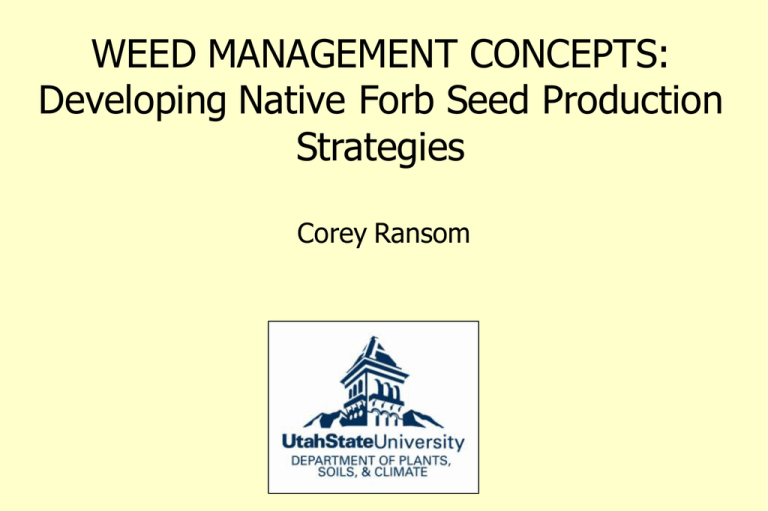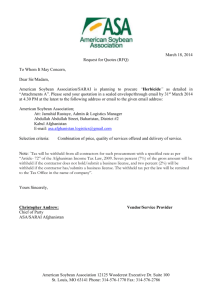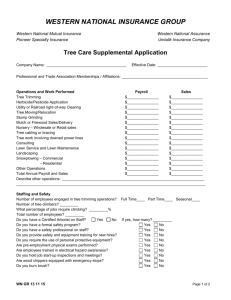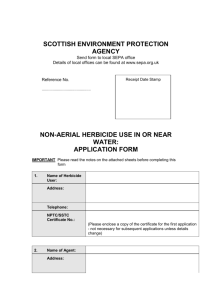WEED MANAGEMENT CONCEPTS: Developing Native Forb Seed Production Strategies Corey Ransom
advertisement

WEED MANAGEMENT CONCEPTS: Developing Native Forb Seed Production Strategies Corey Ransom Methods of Weed Control • • • • • Preventative Biological Cultural Mechanical Chemical Preventive Weed Control in Row Crops • • • • • Clean equipment (planting, cultivating, harvest) Clean field borders Weed screens for irrigation water Prevention of weed seed production Spot treatment Cultural Control • • • • • • • • • Crop rotation Site selection Stale seedbed Seedbed preparation Proper planting date/depth/conditions/density Competitive varieties/disease resistant/vigor Disease and insect management Fertility management/placement Irrigation management – Drip? Physical and Mechanical Control • • • • • • • Preplant Tillage or Cultivation Preemergence Cultivation In Crop Cultivation Blind Cultivation Mulches Flaming (nonselective/selective) Handweeding Opportunities to innovate cultivation tools Hand weeding intra-row weeds Time consumption for hand weeding Crop Hour/ha Onion sown 100-400 Carrot sown 100-400 Sugarbeet sown 80-150 Transplants 20-50 DIAS Chemical Weed Control Few herbicides that could currently be legally used to control weeds in native forb seed production. We need to identify and label herbicides that can be used to selectively control weeds in our forb seed crops. Herbicide Selectivity Definition - a treatment that at a given dosage is toxic to some plant species but does not damage others. Herbicide Selectivity Mechanisms (Physical): 1. Timing of herbicide application relative to crop growth (Roundup while crop is dormant) 2. Herbicide placement relative to: - Pattern of crop growth and development - Contact with plants (banding, drop nozzles) Herbicide Selectivity Through Placement/Timing Selective Placement Hooded band sprayer - can shield spray or plant - generally use herbicide that is not systemic www.wyliespraye rs.com Herbicide Selectivity Mechanisms (Physiological): 1. 2. 3. 4. Differential Differential Differential Differences absorption (includes retention) translocation. metabolism. in sensitivity at the target site. Herbicide Selectivity Due to Plant Physiology Physiological – differences in plant growth Herbicide Selectivity Due to Plant Physiology Physiological – Differences in plant growth Ex. Contact herbicides in perennial crops. Objective – Herbicides for Seed Production Identify herbicides for weed management in forb seed production. - Basalt milkvetch - Western prairie clover - Searls’ prairie clover - Tapertip hawksbeard Initial Preemergence Herbicide Screen -50 seeds per flat. -50/50 Sandy Loam Soil with peat and vermiculite potting soil. -sprayed in chamber at 20 gpa. -Crepis stored at 34 F for 3 weeks. -evaluated 4 weeks after treatment. Species: - Basalt milkvetch - Western prairie clover - Searls’ prairie clover - Tapertip hawksbeard Preemergence Herbicides and Rates Kerb 1.0 Treflan 0.375 Prowl H2O 0.75 Outlook 0.656 Sencor 0.375 Plateau 0.0625 Olympus 0.0267 Chateau 0.047 Tapertip Hawksbeard Symptoms Kerb Untreated Sencor Olympus Treflan Prowl H2O Plateau Basalt Milkvetch Symptoms Prowl H2O Outlook Sencor Olympus Treflan Kerb Western Prairie Clover Symptoms Prowl H2O Outlook Untreated Treflan Olympus Postemergence Herbicide Screening, 2009 Conducted on fields established in 2005 as transplants from conetainers. Plants were spaced 0.5 m. Herbicide treatments applied May 12, 15, and 21, 2009. Applications made with a shielded bicycle sprayer at 20 gpa and 30 psi. Multiple accessions and inconsistent plant vigor prior to treatment add to variability in these trials. Herbicide Treatments on Basalt Milkvetch Herbicide Rates lb ai/A product Buctril 0.25 1.0 pt 2,4-DB 0.25 1.0 pt Transline 0.124 0.33 pt Paramount + MSO 0.248 0.33 lb Raptor + MSO 0.078 10.0 oz MSO at 1.0% v/v • Application made May 15. • Injury evaluated May 26 (11 DAT) and June 23 (41 DAT). • Biomass taken July 23. Basalt Milkvetch Injury on May 23 and June 25 70 60 11 DAT 41 DAT Injury (%) 50 40 30 20 10 0 Buctril 2,4-DB Transline Paramount Raptor Treatment • Transline again caused significant season long injury • 2,4-DB , Paramount, and Raptor had among the least injury Milkvetch Plant Weight in Response to Herbicides 25 a Biomass (g/plant) 20 15 a a a b 10 b 5 0 Untreated Buctril 2,4-DB Transline Paramount Raptor Treatment • Buctril and Transline significantly reduced plant biomass. Millkvetch Flowering in Response to Herbicides 12 a Flowering (plants/plot) 10 8 6 ab 4 bc bc 2 bc c 0 Untreated Buctril 2,4-DB Transline Paramount Raptor Treatment Herbicide Injury in Basalt Milkvetch Herbicide Treatments on Western Prairie Clover Herbicide Rates lb ai/A product Prowl H2O 0.71 1.5 pt Outlook 0.84 18.0 oz Goal 0.25 0.66 lb 0.064 1.0 pt Sencor + NIS 0.5 0.66 lb Buctril 0.25 1.0 pt 2,4-DB 0.25 1.0 pt Transline 0.124 0.33 pt Paramount + MSO 0.248 0.33 lb Raptor + MSO 0.078 10.0 oz Milestone 0.047 3.0 oz Chateau + NIS NIS at 0.25% v/v MSO at 1.0% v/v • Applied May 21. • Injury evaluated May 26 (5 DAT) and June 25 (35 DAT). • Plant biomass and seed head biomass August 6. Western Prairie Clover Response to Herbicides Injury Herbicide 5 DAT Biomass 35 DAT ----------------%-------------- Veg. Seed head ----------g/plot---------- Untreated - - 520 243 Prowl H2O 10 1 545 203 6 4 616 189 Goal 64 26 513 218 Chateau + NIS 56 18 479 203 Sencor + NIS 21 5 571 140 Buctril 13 14 337 126 2,4-DB 23 10 393 150 Transline 41 44 416 32 Paramount + MSO 25 10 704 191 Raptor + MSO 38 18 446 185 Milestone 35 63 257 2 Outlook Herbicide Injury in Prairie Clover Impact of Application Timing • No herbicide injury was evident in 2008 when applications were made while prairie clover was dormant. • Significant injury appeared when actively growing prairie clover was treated in 2009. Issue of crop selectivity vs. weed efficacy. Conclusions – Seed Production 1. 2,4-DB warrants further investigation for postemergence use in basalt milkvetch. 2. Established western and Searls’ prairie clover appear to tolerate postemergence treatments of several herbicides, but impact on seed yield and viability has not been determined. 3. Transline and Milestone is too injurious for potential use. 4. Likely, the use of soil active herbicides will continue to cause minimal damage to established plants. Herbicides That Could Have Great Utility 1. Graminicides – Poast, Select, etc. 2. Preemergence herbicides used in established plantings - Prowl, Outlook 3. Preemergence soil active herbicides for establishment? 4. Postemergence herbicides – Contact and Nonselective 5. Postemergence herbicides – Selective Where Do We Go From Here? Need to have herbicides registered for use in native seed crops. 1. Small acreage high value crops 2. Require “Third Party” indemnification label 3. Who will hold the label? USDI BLM Great Basin Restoration Initiative, GBNPSIP, and USDA FS Rocky Mountain Research Station




